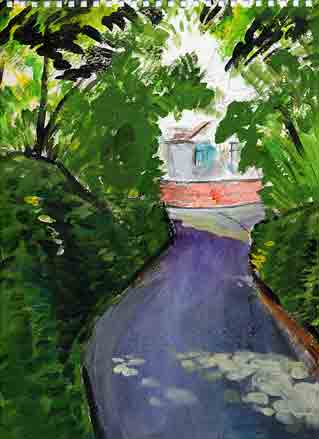The Lyme Maze Game

|
The tradition is that this is a Roman road, as the sign near the bridge declares. This is dubious, but it is certainly an ancient way. After a broad beginning (the gate on the left reveals a field of Slopes Farm) the lane climbs past a bower of ferns that looks like fun for children to play in, and then between high banks clad with blue-green ivy, in a narrow groove made tunnel-like by foliage closing overhead. The groove is sinuous because it must once have been the course of a rivulet, which comes out in the waterspout high up the riverbank beside Horn Bridge. This lane is one of those places where, on a bicycle, you are pestered by pesky cars that cannot get by you and roar slowly uphill behind you. The spots of sunlight on the tarmac of this shady lane: something is noticeable about them. The top comes in sight.
A broad sloping space opens out, in which Roman Road crosses Haye Lane. You can heave up the slope on the right onto this. Or keep around the curve to the left, whereupon you will see that while this continues as Haye Lane, Roman Road itself continues as a rightward branch that looks like a mere driveway. So there is quite a squiggle in what is supposed to have been a route laid down by those straight-line-minded Romans, making it even harder to imagine a platoon in helmets and greaves marching up this hill. |
